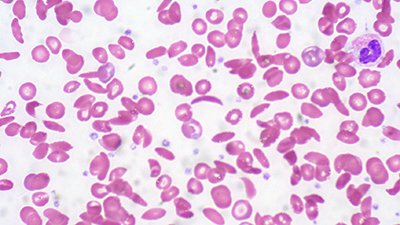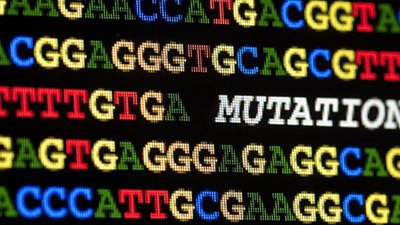Mutations
Do Mutations Drive Evolution?
In the evolutionary model, mutations are hailed as a dominant mechanism for pond-scum-to-people evolution and provide “proof ” that the Bible’s history about creation is wrong. But are we to trust the ideas of imperfect, fallible men about how we came into existence?
Mutations and New Genetic Information
If new genetic information—required to build eyes where there are none, for example—does not occur in nature, then evolution is stuck in the water. For evolutionists, the solution comes in the form of mutations. The problem is that the only beneficial mutations ever observed do not add new information to the genome.
Mutations in Viruses
This study illustrates the fact that natural selection can operate on a series of mutations and even on other organisms to produce a population change with a noticeably new characteristic. Yet for all that, the result was diversity within a kind.
Mutations Could Help in Finding HIV Vaccine
Human Immunodeficiency Virus (HIV) has frustrated efforts to create an effective vaccine. Analysis of naturally developed antibodies in a few infected patients, however, has uncovered a pattern in HIV mutations, a pattern that could be the key to developing an HIV vaccine.
Articles About Mutations
-
July 21, 2024 from Answers Magazine
When it comes to people with disabilities, Christians need to rethink what it means to be “fearfully and wonderfully made.”
-
Feb. 24, 2024 from Essays on Origins: Creation vs. Evolution
The survival of living species depends on its ability to pass on its genetic instructions, from generation to generation, without significant alteration.
-
July 22, 2022 from Answers in Depth
Did a bacteria colony just prove gain-of-function mutations exist?
-
Sept. 22, 2018 from Refuting Common Evolutionist Claims
Neo-Darwinism offers this basic equation for evolution: mutations + natural selection + millions of years = particles-to-person evolution.
-
Jan. 4, 2017 from Answers in Depth
If we share a common ancestor with a chimpanzee, as evolutionists confidently maintain, then how did our brains leap so far ahead in size and capability?
-
Semi-Technical In-Depth ArticleJust How Random Are Mutations?Aug. 18, 2016 from Answers in Depth
Changes to the sequence of nucleotides (e.g., mutations) can alter the genetic information of the organism, which, in turn can alter its physical features
-
Book Chapter2.8 Mutation-Selection in Biblical PerspectiveMarch 28, 2016 from Creation: Facts of Life
Mutations are no real help in explaining the origin of species, but they are great for explaining the origin of disease, disease organisms, and birth defects.
-
Book Chapter2.5 Mutations, Yes; Evolution, NoMarch 28, 2016 from Creation: Facts of Life
Contrary to popular opinion, drug resistance in bacteria does not demonstrate evolution.
-
July 1, 2015 from Answers Magazine
Evolution would require an enormous amount of change. Modern laboratory experiments have tested bacteria’s ability to change. Is this ability truly unlimited?
-
Semi-Technical In-Depth ArticleHijacking Good Science: Lenski’s Bacteria Support CreationAug. 13, 2014 from Answers in Depth
Lenski's long-term evolution experiment does not distinguish between observable limited change and unobservable molecules-to-man evolution.
-
Selective Switch Toggles Bacterial Traits While “Bacteria Evolve with Predictable Results”Aug. 26, 2013 from News to Know
Gluttonous bacteria on the fast track compete with biofilm-makers boldly going where bacteria haven’t gone before.
-
From Bacteria to Giraffes: Adapting Reality to FantasyJuly 13, 2013 from News to Know
What can pink shower scum tell us about the origin of the giraffe’s long neck?
-
HIV Mutation Possibly More Vulnerable to VaccinesNov. 3, 2012 from News to Know
HIV mutation may make it more vulnerable to vaccines.
-
New Function through Gene DuplicationNov. 3, 2012 from News to Know
Evolutionists claim to have demonstrated the evolution of a new function through gene duplication.
-
De-Regulation of an Existing TraitOct. 6, 2012 from News to Know
Genome analysis confirms “a key evolutionary innovation” is only de-regulation of an existing trait.
-
Mutated Sense of TasteMarch 17, 2012 from News to Know
Many meat-eating mammals have mutated sweet sense.
-
Scientists Admit Genetic Data Timing UncertainMarch 17, 2012 from News to Know
“The inability to observe past mutation rates means that the timing of events from genetic data remains uncertain,” report Cambridge geneticists.
-
The Ancient Mega-CloneFeb. 11, 2012 from News to Know
Models suggest massive Mediterranean meadows are millenary mega-clones.
-
Mutational Secrets of a VirusFeb. 4, 2012 from News to Know
Series of mutations said to evolve a “key innovation”
-
Molecular Time-TravelJan. 14, 2012 from News to Know
“Molecular machine’s evolutionary trajectory” is an imaginary marvel.
-
Link Between Sickle-Cell and Malaria ResolvedNov. 19, 2011 from News to Know
Mysterious malarial link to sickle-cell mutation resolved
-
Can Accumulated Mutations Produce New Species?Aug. 20, 2011 from News to Know
Can three walk together and evolve into one?
-
Genome Structure Over Genetic Mutations: What Makes You DifferentAug. 13, 2011 from News to Know
The genomic forest is harder to see than its trees.
-
Cryptic MutationsJune 18, 2011 from News to Know
Cryptic variation and preadaptation—fancy words for the obvious.
-
Leaping MutantsJune 18, 2011 from News to Know
Statistics suggest a way for eukaryotic mutants to leap over fitness valleys.
-
Evolution is Just MistakesJan. 29, 2011 from News to Know
A major fault line between creationists and evolutionists concerns the appearance of novel genetic information in nature. What does the latest research say about what’s supposed to be the driving force of evolution?
-
Fruit Flies and Advantageous MutationsSept. 25, 2010 from News to Know
A study of 600 generations of fruit flies, just reported in Nature, sought to unravel the mystery of how advantageous mutations could become fixed in the population.
-
Semi-Technical In-Depth ArticleThe Effect of Mutations Down on the FarmJune 2, 2010 from Answers in Depth
A closer look at how different mutations affect livestock can give a better understanding of the role mutations play in our world.
-
"Directed Evolution" in MIT LaboratoryMay 15, 2010
“Directed evolution” sounds like a page out of the theistic evolutionist’s playbook. So what’s it doing turning up in an MIT laboratory?
-
Making the Evolution Pill Easier to SwallowNov. 9, 2009
According to one presenter at a recent Darwin and medicine conference, children with birth defects are “bumps” in the road on our way to becoming more evolved.
-
Are You a Mutant?Sept. 5, 2009 from News to Know
A team of researchers has added to our knowledge of the genetic mutation rate in humans, as they report in Current Biology.
-
Leaps of Developmental LogicJuly 25, 2009 from News to Know
Small biological changes that take generations—like some birds’ beaks growing longer or shorter in certain ecological niches—can be explained and understood by creationists and evolutionists. But when it comes to explaining developmental “leaps,” evolutionists must make a leap of logic.
-
Technical In-Depth ArticleAnalysis of Barry Hall’s Research of the E. coli ebg OperonJune 3, 2009 from Answers in Depth
Much research has been done on the ebg operon of the bacterium Escherichia coli over the last 30 years. specific mutations within this operon enable the bacterium to metabolize lactose.
PDF Download -
Technical In-Depth ArticleA Creationist Perspective of Beneficial Mutations in BacteriaMay 27, 2009 from Answers in Depth
Creationists have tended to offer an inconsistent or incomplete perspective of “beneficial mutations” within a creation framework.
PDF Download -
Semi-Technical In-Depth ArticleAre Some Mutations Directed?March 4, 2009 from Answers in Depth
Scientific American recently described the molecular basis for a number of traits as supporting evolution, but a closer looks reveals that there’s more to mutation than randomness.
PDF Download -
A Reminder That DNA Mutations Are More Counterproductive Than HelpfulDec. 6, 2008
From mid-November, a reminder that mutations are nearly always counterproductive.
-
Semi-Technical In-Depth ArticleA Poke in the Eye?June 30, 2008 from Answers in Depth
Has E. coli “evolved” new complex traits in the lab? Or is this more evidence of evolutionists grasping at anything to promote their ideas?
PDF Download -
Semi-Technical Feedback ArticleAre There Beneficial Mutations?April 25, 2008 from Feedback
What are beneficial mutations? Does AiG need to change its stance regarding them? Dr. Georgia Purdom, AiG–U.S., clarifies this often-contentious area.
-
Semi-Technical Feedback ArticleEvidence of New Genetic Information?Feb. 1, 2008 from Feedback
Can duplication and mutations cause new information to “arise” in the genome? Dr. Georgia Purdom accepts this challenge posted to creationists.
-
Scientists Raise the Dead and Kill the LivingNov. 4, 2006
Scientists have “reversed evolution”-converting a modern enzyme into its “theoretical distant ancestor” in one case, and reactivating a supposedly five-million-year-old retrovirus in the other.
-
How We Got Red Hair (It Wasn’t By Evolution)May 3, 2006
Recent research has shown that red hair in people often results from mutations in just one gene.
-
A Feet of ImaginationMarch 17, 2006
No story related to human evolution has drawn as much press in recent times as the account of family members in Turkey who walk hunched over, using their hands as well as feet to ambulate.
-
Special Tools of LifeMay 12, 2004
Did you know that living things make their own tools? For example, they use enzymes to break down large molecules for parts (building blocks) and some for energy.
-
Technical Research PaperProtein Mutational Context Dependence: A Challenge to Neo-Darwinism Theory: Part 1April 1, 2003, pp. 117–127
Whenever amino acids can be changed at a residue position, it is generally assumed this mutation is compatible with all other tolerated residue substitutions. We show here that this cannot be assumed.
-
Semi-Technical Research PaperAncon Sheep: Just Another Loss MutationApril 1, 2003, pp. 18–19
A major problem for Darwinists is that the Ancon mutation (a Mendelian recessive), as is true with most other mutations, is a loss mutation.
Recommended Resources

Answers in Genesis is an apologetics ministry, dedicated to helping Christians defend their faith and proclaim the good news of Jesus Christ.
- Customer Service 800.778.3390
- Available Monday–Friday | 9 AM–5 PM ET
- © 2025 Answers in Genesis











